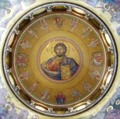Armenian Apostolic Church
The Armenian Apostolic Church (Armenian: Հայ Առաքելական Եկեղեցի), sometimes called the Armenian Orthodox Church or the Gregorian Church, is the world's oldest national church and one of the most ancient Christian communities.
Origins and history

The earliest Christian accounts of the introduction of Christianity into Armenia date from the 1st century. The Church teaches that it was first preached by two Apostles of Jesus, St. Bartholomew and St. Thaddeus. The Armenian Apostolic Church claims to been in existence since the days of the apostles and therefore would be one of the oldest denominations of Christianity. Armenia was the first country to adopt Christianity as its official religion, in 301, when St. Gregory the Illuminator converted Tiridates III (the King of Armenia) and members of his court[citation needed]. The Church teaches that St. Gregory was imprisoned by Tiridates in an underground pit, called Khor Virab, for 13 years, after which he healed the King of an incurable disease, whereupon Tiridates accepted Christianity[citation needed].
The official name of the church is the "Armenian Orthodox Apostolic Church"; "Gregorian Church" is not preferred by the church, as they view the Apostles Thaddeus and Bartholomew as the founders, and St. Gregory as merely the first official head of the church.
Christianity was strengthened in Armenia by the translation of the Bible into the Armenian language by the Armenian theologian, monk and scholar Saint Mesrop Mashtots.
Monophysite label
Historically, the Armenian church has been labeled monophysite because it (just as the Coptic Orthodox Church) rejected the decisions of the Council of Chalcedon, which condemned monophysitism. The Armenian Church officially severed ties with the West in 554, during the second Council of Dvin where the dyophysite formula of the Council of Chalcedon was rejected.
However, the Armenian Orthodox Church argues that this is a wrong description of its position, as it considers Monophysitism, as taught by Eutyches and condemned at Chalcedon, a heresy and only disagrees with the formula defined by that council. The Armenian church instead adheres to the doctrine defined by Cyril of Alexandria, considered as a saint by the Chalcedonian churches as well, who described Christ as being of one incarnate nature, where both divine and human nature are united. To distinguish this from Eutychian and other versions of Monophysitism this position is called miaphysitism.
In recent times, both Chalcedonian and anti-Chalcedonian churches have developed a deeper understanding for each other's positions, recognizing the substantial agreement while maintaining their respective theological language. Hence, the Monophysite label is avoided to describe the Armenians' or Copts' belief regarding the Nature of Christ.
Structure and leadership
| Part of a series on |
| Eastern Christianity |
|---|
 |
The Armenian Apostolic Church is headed by a Catholicos (the plural is Catholicoi). (The Armenian Apostolic Church should not be confused, however, with the Armenian Catholic Church, which is an Eastern Catholic church in communion with the See of Rome (whose bishop is the Pope). At present, the Catholicos of All Armenians is his Holiness Karekin II (sometimes spelled as Garegin), who resides in the city of Echmiadzin, west of Yerevan. A second Catholicos, His Holiness Aram I Catholicos of Cilicia, who resides in Antilyas in Lebanon, leads churches belonging to the Holy See of Cilicia. The division stems from frequent relocations of the Church headquarters under Ottoman Rule and was further reinforced during the period in which Armenia was part of the Soviet Union. However, the Catholicos of All Armenians claims theoretical sovereignty over the Catholicos of Cilicia. The Armenian Apostolic Church is one of a few denominations in the world to have a democratic system; the people decide if they want to keep priests in their churches and may ask for different ones, as do some other connectional ecclesial structures, such as Presbyterians.
Similarities to other churches
Liturgically speaking, the Church has much more in common with the Latin rite in its externals, especially as it was at the time of separation, than the Eastern Orthodox Churches. For example, their bishops wear mitres almost identical to those of Western bishops. They usually do not use a full iconostasis, but rather a curtain (which was also used in the West at the time of separation). The liturgical music is Armenian chant.
Armenian priests below the rank of bishop are allowed to marry and their descendants' surnames are prepended with prefix "Ter" (or "Der" in Western Armenian, meaning "Lord"), to indicate their lineage.
Today
Today there are large Armenian Apostolic congregations in many countries outside Armenia, including Russia, Georgia, France, the United States, Lebanon, Syria, Canada, and others. Of particular importance is the Armenian Apostolic Church of Iran (see also Christians in Iran) and the Armenian Patriarchate of Constantinople. Armenians represent the largest Christian ethnic minority in both of these predominantly Muslim countries.
References
- David Marshall Lang.Armenia: Cradle of Civilization. London:George Allen and Unwin. 1973.
External links
- The Armenian Church
- Catholicosate of the Great House of Cilicia
- Armenian Patriarchate of Jerusalem
- Armenian Patriarchate of Constantinople
- Araratian Patriarchal Diocese
- Diocese of the Armenian Church of Canada
- Diocese of the Armenian Church of America (Eastern)
- The Diocese of the Armenian Church of America (Western)
- Armenian Apostolic (Orthodox) Church Library Online: English | Armenian | Russian
- Prayer Book of the Armenian Church

